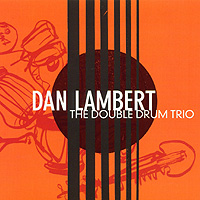 It’s
great to hear an acoustic guitarist who so clearly has such a fondness
for the rock edge. That’s the story with the 2010 CD from El
Paso based guitarist Dan Lambert entitled The Double
Drum Trio. Already creating a stir in the guitar world,
Lambert is joined by multi-percussionists Ricardo Amaya and
Erik Hickerson. Lambert turns in a fine performance on acoustic
guitars as well as more exotic Middle Eastern instruments like sarod,
oud and ruan. Perhaps the coolest thing here is just how well
the double drum sound embellishes Lambert’s moods and guitar
tracks. Not only is it derivative of the acoustic guitar genre but
Lambert isn’t afraid to bring in shades of World Music, rock,
New Age, jazz and surf-rock. Even though mainly acoustic and very
easy on the ears in general, some tracks feature an electric guitar
sound in an astoundingly simulating way. In fact, the lead off track
“Wadi A Go-Go” is like a surf music possessed Leo Kottke
and Ralph Towner jamming with The Ventures. The CD is superbly recorded
and the artwork kind of captures that bizarre early ‘60s vibe
when Martin Denny, The Ventures and John Fahey were all in their prime.
Amazing beyond words, follow The Double Drum Trio down to Lambertland.
www.DanLambertGuitar.com
It’s
great to hear an acoustic guitarist who so clearly has such a fondness
for the rock edge. That’s the story with the 2010 CD from El
Paso based guitarist Dan Lambert entitled The Double
Drum Trio. Already creating a stir in the guitar world,
Lambert is joined by multi-percussionists Ricardo Amaya and
Erik Hickerson. Lambert turns in a fine performance on acoustic
guitars as well as more exotic Middle Eastern instruments like sarod,
oud and ruan. Perhaps the coolest thing here is just how well
the double drum sound embellishes Lambert’s moods and guitar
tracks. Not only is it derivative of the acoustic guitar genre but
Lambert isn’t afraid to bring in shades of World Music, rock,
New Age, jazz and surf-rock. Even though mainly acoustic and very
easy on the ears in general, some tracks feature an electric guitar
sound in an astoundingly simulating way. In fact, the lead off track
“Wadi A Go-Go” is like a surf music possessed Leo Kottke
and Ralph Towner jamming with The Ventures. The CD is superbly recorded
and the artwork kind of captures that bizarre early ‘60s vibe
when Martin Denny, The Ventures and John Fahey were all in their prime.
Amazing beyond words, follow The Double Drum Trio down to Lambertland.
www.DanLambertGuitar.com
mwe3.com
presents an interview with
DAN LAMBERT
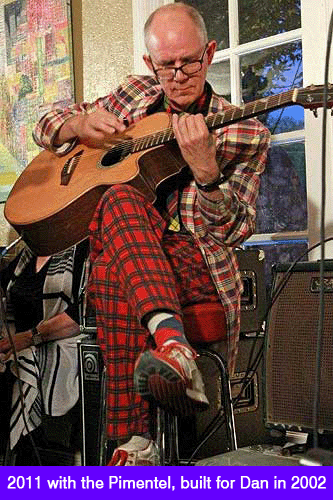 mwe3: How
long have you been recording and playing guitar? Where did you grow
up and how did that impact your early musical upbringing and influences?
mwe3: How
long have you been recording and playing guitar? Where did you grow
up and how did that impact your early musical upbringing and influences?
DL: I was always fascinated with music, collecting records, catching
music shows on TV, hearing live acts, but I didn’t start playing
until landing at the University of Illinois in Champaign, IL in the
early ‘70s. The place was a hotbed for great players, all different
styles, plus there were all the traveling acts that came through.
REO Speedwagon with Gary Richrath was a local bar band, Mike Murphy’s
One Eyed Jacks, Slink Rand, Duke Tomato. Dan Fogelberg was in my freshman
Geology class!
I fell in with a group of players who’d been around, knew what
they were doing, and who took me under their wing. They turned me
on to the Allman Bros...I am eternally grateful for that. Duane’s
improvisational flair has been an inspiration ever since. Tom Biagi
and William F. Hill were two guitar players that passed through that
group of players the couple years that I was with them, good local
cats to learn from.
I also started backing up a singer named Mike Miles in a folk music
duo. On a playing trip with him to Carbondale, IL an agent took me
aside and played me Norman Blake’s Home In Sulphur Springs
album. All that music from one guitar. I was hooked! I’ve had
a big time love affair with acoustic guitar ever since. The whole
U of I experience was like going to Music 101 through your doctoral
thesis, only I was doing it in the clubs and coffeehouses up and down
the state. It was the best musical upbringing someone interested in
rock-jazz-blues-world-folk could have.
mwe3: How about where you are living nowadays and what do you like
about where you live now?
DL: My wife and I have been in El Paso since 1976. Between Las Cruces
and El Paso there’s a good scene here for solos, duos, trios.
I also travel the length and breadth of New Mexico, so we get around.
You have to be versatile as far as doing some gigs solo, using a duo
for a bigger sound—guitar and percussion or guitar and bass—and
even putting together bigger ensembles for the gigs that call for
it. There are a bunch of good players around here to call on.
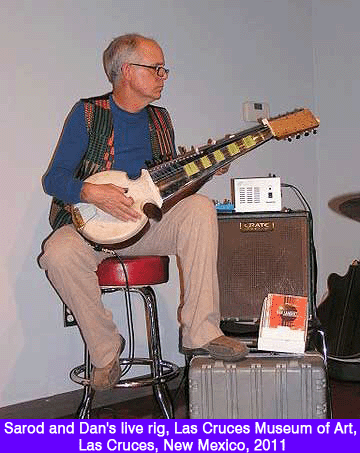 Some of
the places I’ve played at for 10 years plus!
Some of
the places I’ve played at for 10 years plus!
El Paso’s a bit off the beaten path, so you have to work on keeping
in the pipeline. The internet makes it a little easier to stay on
top of things. On and off I travel to play, I used to hit the college
circuit pretty heavy and got sent around by different arts groups
to all sorts of funky places. The local scene has been such a good
place for us the last decade that I’ve gotten a little spoiled.
Releasing the new CD should get me off my ass, traveling more, getting
the music out there.
mwe3: Can you remember your first guitars and these days what do you
look for sound wise in a guitar?
DL: A cheapy 15 dollar acoustic that the neck broke off - I screwed
it back on. That was my first. The first good one was a Les Paul Custom
at the U of I - $300 bucks, all the money in the world at the time.
I had a little mahogany Gibson LG-O that I liked, and graduated to
a J-45 eventually. I’ve gone through just about every guitar
under the sun.
I was out there playing, traveling a bunch and I’d find all sorts
of great buys. I’d fix them up, play them and sell them. It turned
into a tidy little business. I’d find Danelectro amp-in-case
Silvertones for $50 and turn around and sell them for $100. I thought
I was making a fortune! This would have been late ‘70s through
the ‘80s and even into the 90s. However, I had to make the decision,
was I a player or a dealer? Playing won out.
All through those years I had a lot of great sounding guitars, but
I never liked their necks – too tiny. I wanted a big steel string
sound with a classical width neck. I was doing a lot of repair work
and rebuilding basket cases at the time, so I modified some guitars,
an old ’52 Martin 000-28 that looked like a box of kindling when
I first found it. I made a nice wide neck for it. I did the same to
an old Gibson basket case from the 1930s. I used those guitars for
years. I recorded a solo guitar album, The Blue Hand, back
in 2000 with them. They’re pictured on the CD. They were great
sounding and fun to play, but a little fragile. I still have both
of them.
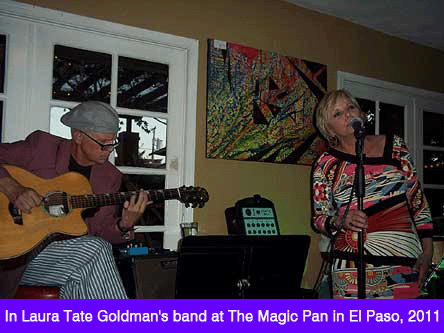 Finally
my wife convinced me to bite the bullet and have someone custom make
me a guitar. I’d been eyeing the Pimentels’ work from Albuquerque.
In 2002 I made the pilgrimage to their shop and sat down with Rick,
he’s the one who makes the steel strings. It was the smartest
thing I’ve ever done - actually, marrying Rachelle back in 1974
was the smartest thing I’ve ever done. The Pimentels even tell
me, “Dan, you’re always welcome at the shop, if you bring
her along!”
Finally
my wife convinced me to bite the bullet and have someone custom make
me a guitar. I’d been eyeing the Pimentels’ work from Albuquerque.
In 2002 I made the pilgrimage to their shop and sat down with Rick,
he’s the one who makes the steel strings. It was the smartest
thing I’ve ever done - actually, marrying Rachelle back in 1974
was the smartest thing I’ve ever done. The Pimentels even tell
me, “Dan, you’re always welcome at the shop, if you bring
her along!”
As an aside, being married to an artist all these years, there are
a lot of similarities in our fields. We inspire each other, talk through
problems, and we’ve both met with success, although along very
different paths. So there’s no jealousy or competition, we’re
there to help.
mwe3: What guitars did you record The Double Drum Trio CD with?
DL: Back to the guitar, I’ve been using that Pimentel for pushing
10 years now, a couple thousand gigs I bet. I used it on the new CD,
as well as a guitar made by Bill Farmer from El Paso. I use the Farmer
on one tune on The Double Drum Trio CD. The Pimentel’s
the main one, the versatile one, the road hog. It’s big and woody,
and dry like the desert. I’m about ready to talk to them about
another one. Robert Pimentel has built me an electric nylon string
guitar that I use for some of the quieter gigs, or for a change of
pace.
mwe3: What strings do you use and do you also play electric guitar?
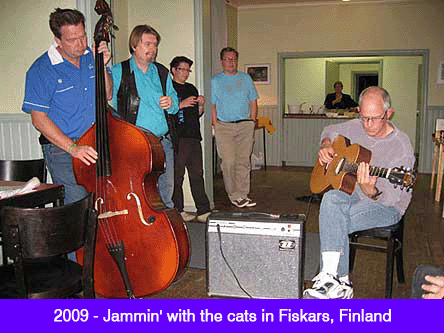 DL: On the
CD a few tunes might sound like an electric, but it’s my Pimentel
through an amp. I play electric a little bit around the house, when
I’m teaching or when I’m trying to figure out an electric
tune off a record, or even for the occasional gig. 99.9% of what I
do is acoustic however.
DL: On the
CD a few tunes might sound like an electric, but it’s my Pimentel
through an amp. I play electric a little bit around the house, when
I’m teaching or when I’m trying to figure out an electric
tune off a record, or even for the occasional gig. 99.9% of what I
do is acoustic however.
I set my acoustics up so they’re easy to play, phosphour bronze
strings with a .011 on top, any brand seems to do, I haven’t
fallen in love with one brand or the other yet.
mwe3: How about amps or effects used on the new album?
DL: Live I use a Crate Gunnison acoustic guitar amp, it’s another
road hog. It sits next to me elevated up on a chair so all the knobs,
the notch filter, everything is right at my fingertips. I also keep
a Raagini
Electronic Tanpura from India sitting on the amp. It’s the
drone you hear on a few tunes on the CD. We use it for the more World
Beat sounding pieces, or whenever I want a nice drone happening. Since
I’ve been playing sarod, oud, ruan and now sitar at gigs, we’ve
been using the drone more and more. You can hear the sarod, oud and
ruan on the CD.
mwe3: Can you say something about the other musicians recording with
you on the Double Drum Trio CD and how about players you work
with live and what did you set out to achieve on the Double Drum
Trio album?
DL: Ricardo Amaya and Erik Hickerson, both excellent percussionists,
play with me on the CD. I do a lot of gigs, and can easily wear out
players, so I have a whole slew of them from the El Paso – Las
Cruces area that I draw from—percussionists, bass players, other
guitar players, singers, violin, flute, cello, you name it. I like
mixing things up, it keeps me from getting stale and it makes it interesting
for the audience.
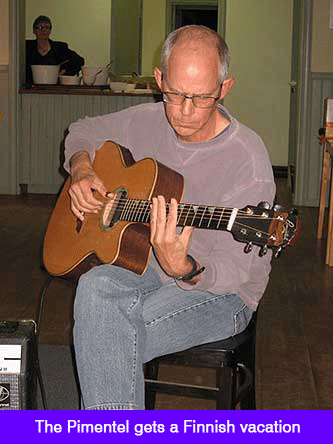 Recording
the CD sort of fell into my lap. We were at a gig and Tony Rancich,
the owner of Sonic Ranch in Tornillo outside of El Paso, was there.
He took me aside and said, “You guys gotta record, people have
to hear this!” I thought yeah, yeah, yeah, salesman’s schtick,
he just wants us to record at his place. I’m a salesman myself.
Again my wife intervened, she told me to get my butt out there and
check out the place. I did. It was great.
Recording
the CD sort of fell into my lap. We were at a gig and Tony Rancich,
the owner of Sonic Ranch in Tornillo outside of El Paso, was there.
He took me aside and said, “You guys gotta record, people have
to hear this!” I thought yeah, yeah, yeah, salesman’s schtick,
he just wants us to record at his place. I’m a salesman myself.
Again my wife intervened, she told me to get my butt out there and
check out the place. I did. It was great.
Ricardo and Eric and myself hunkered down for two days there. We did
it all live, a few takes of each tune to work out the arrangements,
lots of improvising. I could write a book about the experience. The
studio is out in the middle of miles of pecan groves along the Rio
Grande southeast of El Paso, in what they call the Lower Valley. It
was the best setting, get up in the morning early, take a long bike
ride under the shade of the pecan trees, eat, record. We stayed overnight
out at the ranch. Normally recording is a pain, a lot of fussy work,
I’d rather be out playing for an audience. Recording The Double
Drum Trio CD at Sonic Ranch was the best. It’s a special
place.
mwe3: What guitarists and musical styles had the biggest impact on
you and can you hear your influences in the music? For instance, the
first song on the Double Drum Trio album “Wadi A Go Go”
sounds like Leo Kottke jamming with the Ventures!
DL: I’ve listened to a zillion players, all with something to
offer. The ones who have really made their mark on my playing are
Duane Allman, Jerry Hahn, Clarence White, Baden Powell, and Erkan
Ogur. Now there’s a mixed bag for you! And don’t forget
Amjad Ali Khan and Ali Akbar Khan on sarod. I’ve missed important
ones I’m sure, but that’s a start.
mwe3: How do you feel about cross-pollinating musical genres and how
do you think that comes out in your music? For instance, New Age guitar
with World Beat can lead to some amazing different sounds. What are
some of the wildest guitar sounds you’ve ever heard?
DL: I love it all - oud players, African kora players, koto from Japan,
pipa and ruan from China, of course veena, sarod, and sitar from India,
besides all the guitar players. And what about the classic John Coltrane
quartet with McCoy Tyner, Elvin Jones and Jimmy Garrison, or Keith
Jarrett’s “Standards” trio with Jack DeJohnette and
Gary Peacock. There is so much music to pick up on, and I can’t
help but try to interject whatever I hear from any instrument in my
playing. It’s all out there, I just have to be creative enough
to fit it in.
Here’s a story – My wife and I lived in Kent, Ohio for the
first two years we were married, 1974 – 1976, while she was in
grad school. There was a strong traditional music scene happening
at the time, old time music especially. I learned a lot about the
beauty of traditional fiddle tunes, where the different ones came
from, different regional styles, on and on. However, they were pretty
strict about “keeping within the tradition” to the point
that it tended to suck the life out of the music.
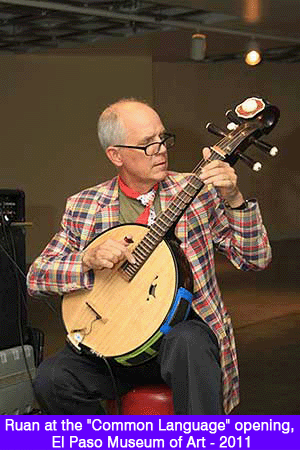 I never
saw the point, I always thought that you brought whatever you could
to the table, that you let your personality shine through. I learned
that from listening to Duane, but not just him. Listen to the great
fiddler Clark Kessinger, especially the recordings with Gene Meade
on guitar. Meade goes wild with the backup, it really injects energy
into the rhythm.
I never
saw the point, I always thought that you brought whatever you could
to the table, that you let your personality shine through. I learned
that from listening to Duane, but not just him. Listen to the great
fiddler Clark Kessinger, especially the recordings with Gene Meade
on guitar. Meade goes wild with the backup, it really injects energy
into the rhythm.
There’s a classic album, Coltrane Plays The Blues. Every
guitar player should learn every tune and solo. Trane could be as
gut-bucket or as modern as he wanted, all in the same tune, and it
all had that unmistakable sound.
My brother-in-law had a girlfriend, Connie Koralik, who played with
The Rosehip String Band, an early Flying Fish Records act. They were
our heroes, Rachelle and I went to tons of their gigs. I remember
a folk nazi in Ohio giving me grief about them when their first record
came out—it was folkie stuff, but with a definite individual
stamp to it. Right then I realized a couple things, number one –
quality is not apparent to everybody and, number two - people can
get downright ugly when you start shaking the foundations of their
known world.
To me it’s always been, the more the merrier. When I’m teaching
and a younger person tells me, ‘I don’t like that kind of
music’ I always say, ‘You’re a little too young to
be so narrow-minded, aren’t you?’
Lately I’ve been listening to violin players, and reading about
violins, the great historic ones. I picked up an album entitled The
Glory of Cremona—six Strads, five Guarneri del Gesus, two
Amatis, a Bergonzi and a da Salo played with piano accompaniment.
It’s a fascinating release, hearing this great player, Ruggiero
Ricci play all these old violins, the history of each being written
up in the liner notes. It’s the most money I’ve ever spent
on a record album, but well worth it. There’s a goal to shoot
for, getting that perfect tone quality that one of those violins is
producing, only on guitar. Makes me want to start all over, this time
as a classical violinist. Imagine having a gorgeous-sounding 300 year
old violin right under your nose, and you’re bringing the best
out of it.
About those wild guitar sounds, how about Robert Nighthawk on that
Live On Maxwell Street LP, the song “Goin’ Down To
Eli’s”.
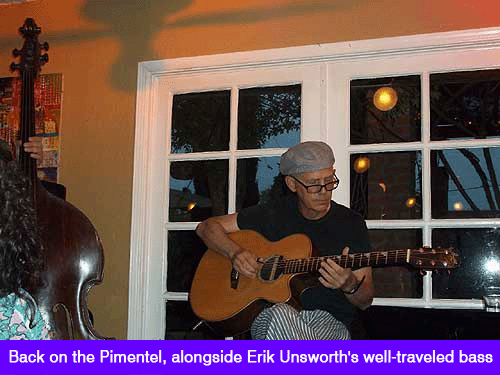 mwe3: You
recently traveled to London. What was that like and do you have family
roots there? Were you influenced by the music from England?
mwe3: You
recently traveled to London. What was that like and do you have family
roots there? Were you influenced by the music from England?
DL: Our family roots are scattered all over the place, Corsica, the
Baltics, Scotland (Buchanan), you name it. Lambert was an adopted
name somewhere along the way, so that throws another wrench in the
works.
The London gigs were set up by a friend, Amrit Sond, a great solo
fingerstyle player, real unique. We had a blast for several days,
plus my wife has a metalsmith friend who lives on the South Downs,
so we spent time there hiking around, walking along the coast. The
UK is such a great place for walking, the Lake District, Scotland,
to a desert rat like me, the countryside is like another planet!
I learned a whole lot about Scottish music during some previous trips
when we’d rented a car and traveled around the country. We discovered
bands like Runrig, and saw what an achingly beautiful place Scotland
is, how the weather can come on in a second, and learned about the
often dark, violent history.
mwe3: Can you say something about your guitar building career?
DL: As far as building guitars, along the way I had to make a choice,
build em’ or play em’. I certainly have an appreciation
for the luthier’s craft. I’ve done a lot of repair work
over the years, and still do some, but I play more than ever, and
there’s only so much time in the day.
mwe3: Do you have any interests of hobbies outside of music?
DL: My wife and I both love being outdoors, we’ve just returned
from a hiking/camping trip to Flaming Gorge, the Uintas mountains
and Dinosaur National Monument. We get up into the mountains in Cloudcroft,
NM as often as we can.
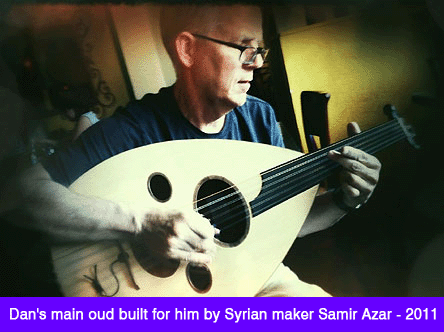 I write
a lot also, lately for What’s Up, an El Paso entertainment magazine.
Some of it’s music oriented, like a monthly column, The Final
Note, on making a living in the biz. I also do profiles of artists
and writers, especially when they have something new out. I like the
challenge and I like keeping my writing chops up. A well-composed
line is universal, whether it’s a piece of writing or an inspiring
melody.
I write
a lot also, lately for What’s Up, an El Paso entertainment magazine.
Some of it’s music oriented, like a monthly column, The Final
Note, on making a living in the biz. I also do profiles of artists
and writers, especially when they have something new out. I like the
challenge and I like keeping my writing chops up. A well-composed
line is universal, whether it’s a piece of writing or an inspiring
melody.
And I’m a big reader, always have been.
mwe3: Also can you say something about some of your very early work
being rereleased on the Wayfaring Strangers CD? How did that come
about and do you have any other music planned to come out from the
archives, live or any other releases planned:
DL: The Double Drum Trio is the ninth release under my own
name, going back to the late 70s. Numero Records out of Chicago got
in touch about putting together a solo fingerstyle guitar compilation
featuring independent artists from the ‘70s and ‘80s. I
fit right in. They used the tune “Charleytown” off my first
LP.
I’d actually like to do a best of from the first four releases
out on LP, which aren’t available on CD. The fifth through eighth
albums are all out on CD. We’ll get around to the reissue of
the first ones sometime, although right now I’m having too much
fun working up new stuff.
 mwe3:
What other things do you have coming up later this year?
mwe3:
What other things do you have coming up later this year?
DL: We’ll just be playing our usual 3-4-5 gigs/week. The Double
Drum Trio did the music for a video, “Watercourse”. I played
ruan on it and Ricardo played water percussion. Erik was along with
us on that one too. It’s part of a larger art show, “Common
Language” done by my wife, metalsmith Rachelle Thiewes and painter
Suzi Davidoff.
I also wrote the text for the book accompanying the show.
I love to practice, and with all those exotic instruments, I have
no problem filling up the day working out new pieces. In fact, I need
to get back to my sitar.
Thanks to Dan Lambert @ www.DanLambertGuitar.com



